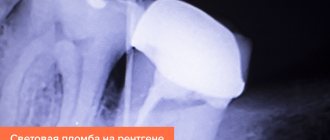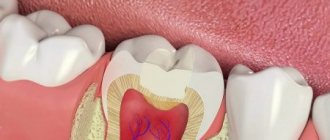Modern dentistry has a large arsenal of high-quality materials for filling teeth. What kind of filling should I put in order to reliably preserve the dental crown from destruction - plastic or ceramic, silicate or cement, chemical or light? Let's take a closer look at the different types of filling material and answer the question which filling is better.
Popular dental materials
Fillings are divided into permanent and temporary. A permanent one is placed when there is minor damage to the tooth crown, a temporary one is used for long-term complex treatment or diagnostics. A temporary filling is also used to protect medicinal compounds during dental treatment: a medicinal compound is placed under it.
The materials from which fillings are made are divided into several types:
- cement, silicate;
- plastic;
- metal, amalgam;
- ceramics;
- composites.
Depending on the material used, fillings are divided into several main types:
- cement;
- composite;
- compomers.
The dental industry also produces other types of fillings - plastic, metal and ceramic.
The most durable material is made from light-curing composite. Such fillings are expensive, but the high price justifies the long service life. The fillings look aesthetically pleasing and have the ability to change their shade with changes in lighting.
The most popular material is dental cement. These fillings are still in demand among patients due to their low cost, high adhesion and strength. The fillings literally stick to the surface of the crown and do not form air gaps.
Cement materials
Cement differs significantly from composite in its lower hardness, however, it is able to protect the tooth from repeated carious development. A disadvantage is the high density of cement compared to tooth tissue: over time, this contributes to the thinning of the crown surface adjacent to the filling.
Cement compositions have three subtypes, according to additives to the main ingredient:
- silicate;
- phosphate;
- glass ionomer.
Silicate compounds are the oldest of all. The material contains special glass mixed with phosphoric acids. The silicate composition has a different release of fluoride, which prevents the development of dental caries. The harmfulness of the material lies in its aggressive phosphoric acid, which destroys the pulp. To neutralize the effect of acid on the pulp tissue, a special gasket made of safe substances was installed.
Phosphate compounds are characterized by fragility and fragility, weak adhesion (adhesion to tooth tissue), and high abrasion. The peculiarity of these fillings is their high toxicity, which provokes the proliferation of aggressive bacteria. This substance (phosphate) does not protect well against the re-development of caries.
Glass ionomer cement is used to treat children. The substance is as close in texture as possible to dental tissue, has high adhesive characteristics and safety. The glass ionomer is illuminated with a special ultraviolet lamp, which promotes rapid hardening of the material and high-quality tooth protection from infection. The advantages of this material include the fluoride contained in the composition, which protects against the development of recurrent caries.
The disadvantages include fragility - softness and instability of the composition. In modern dentistry, strengthened glass ionomer is used, the composition of which is supplemented with metal or ceramic particles. This material is used for filling chewing molars; it is most resistant to abrasion. The last word in the development of dental materials is the production of nanoionomer, which reliably protects dental tissue from infection and the development of caries.
Dental canal filling
Tooth filling most often affects only the upper dental tissues. However, if caries progresses rapidly, and not only the upper tissues are affected, but also the pulp, dental canal filling is required. This more complex and painstaking work is included in the concept of endodontic treatment.
Filling of dental canals is a dental procedure for removing part of the dental tissue, pulp and dental nerves and then filling all the resulting voids with dental filling material.
The procedure differs from installing a conventional filling not only in the duration of the procedure, but also in the need for additional examination. Treatment or removal of tooth roots requires special attention, since incomplete or incorrect removal can lead to the development of inflammation. A damaged nerve will cause unbearable pain and require urgent treatment.
If your tooth is bothering you, you react to changes in food temperature, or your tooth aches when you bite, make an appointment with our dentists. Our clinic is located near the Shchelkovskaya metro station, a 7-minute walk. Our regular patients are residents of the Golyanovo, Izmailovo, Preobrazhenskaya Square, and Cherkizovskaya districts.
Composite compounds
Chemically cured composites were invented as an alternative to simple cement fillings. The composition of the composite includes porcelain, which gives greater strength to the cement. Also, according to their composition, composites are divided into three types:
- acrylic-containing;
- resin (epoxy);
- light-curing.
Of the listed compositions, the acrylic-containing composite has the greatest strength. These fillings are characterized by wear resistance, are little susceptible to abrasion, however, they have a toxic effect on the body. Due to toxicity, acrylic is contraindicated in many patients. Acrylic also often provokes the formation of pulpitis. Another negative feature of acrylic is its high absorbency, due to which the risk of caries increases significantly.
Resin composite material is not highly wear-resistant and durable, however, it is non-toxic and harmless to the body. The disadvantages of resin structures include a change in color after a few years: the fillings darken. Another feature of resin (epoxy) fillings is their excessive fragility: they can break off and be “eaten.” Therefore, it is better not to use epoxy composition on primary chewing molars. Epoxy composite also provokes the development of pulpitis, just like acrylic.
The light-curing composite gains its strength from a halogen lamp. They are also called photopolymer or solar-cured. The disadvantage of this material is the complexity of installation: polishing and grinding of the material is necessary. The filling must be polished every six months to maintain the original tone of the material.
What other disadvantages are typical for this material? These include the following properties of the filling:
- shrinkage after curing;
- possible chipping of the crown wall;
- poor-quality hardening of the material.
The filling can shrink up to five percent of its original volume, which significantly reduces the effectiveness of protecting the tooth. Even with slight shrinkage of the filling, there is a high probability of chipping of the adjacent wall of the dental crown. Due to the technical difficulties of working with a halogen lamp, the hardening of the material may be incomplete - only 70%.
An innovation in modern dentistry is a nanocomposite, the structure of which consists of tiny particles. The nanocomposite is characterized by high adhesion to tooth tissues, providing reliable protection against infection and the spread of caries.
What is the difference between a light filling and a chemical filling?
The main difference between these two types of fillings is the curing method. A conventional (chemical) filling gains strength and is securely fixed in the installation area due to the chemical reaction that occurs between the components of the composite material. Photopolymer fillings become hard under the influence of ultraviolet radiation from a special lamp used by the dentist during tooth restoration.
Since the chemical reaction takes time to start and complete, conventional fillings harden more slowly compared to photopolymer restorations.
Plastic, metal and ceramic compounds
Plastic fillings are also at the peak of popularity, also due to their low price. Plastic has many disadvantages:
- gives significant shrinkage after curing;
- changes its color over time;
- quickly wears out and becomes unusable;
- poorly protects against secondary caries.
Important! Cement and plastic fillings are placed in free dental clinics.
Ceramic compositions
The distinctive characteristics of this material are high strength, lack of shrinkage and aesthetics. Ceramics does not darken during use and is not painted. In modern dentistry, ceramics is considered an almost ideal filling material. Types of ceramics include:
- transparent material;
- pressed material;
- metal ceramics.
The disadvantages include the difficulty of installation: the composition fills the hole in the tooth, like an inlay. The inlay is formed using an impression of a previously sanitized tooth.
Metal alloys
Amalgam material includes a mercury compound along with silver. The dangers of exposure to mercury in the body pose a certain health risk. The advantage of amalgam is its long service life and abrasion resistance.
Another disadvantage of this material is expansion during hardening. If the dentist does not correctly calculate the volume of the filling, the possibility of slight destruction of the crown cannot be ruled out.
Due to the unaesthetic appearance of metal structures, they are used on back teeth or the hidden surface of the crown.
What is the difference between a light filling and a chemical filling: the difference in price
Another difference between light fillings and chemical fillings is the price. Restorations made from photopolymers are more expensive because they have better aesthetics and a longer useful life. The type of filling should be chosen together with the treating dentist, so that only a specialist, having assessed the clinical situation, will be able to choose the optimal type of filling material for the patient.
You can receive high-quality dental treatment and restoration services by contacting our dentistry. We use modern filling materials and successfully restore patients’ teeth in the most difficult clinical cases!
Call us or 8 (926) 100-10-10
Which material to prefer
The dental compositions described above have their own characteristics, advantages and disadvantages. Which filling do you prefer? Which is better - light or chemical (ordinary)? The choice will depend on financial capabilities and the location of the tooth in the oral cavity - posterior molar or frontal.
It is preferable to place fillings made of durable, indelible compositions on posterior chewing molars. For example, metal, glass ionomer or nanocomposite materials.
If we consider from an aesthetic point of view, it is better to put light or ceramic fillings on the front teeth, which are identical to tooth enamel and are invisible when smiling. Light dental products are characterized by a certain fragility, and therefore cannot withstand heavy chewing load on the rear molars.
To restore a chipped or damaged tooth in the front rows, light fillings are used. Using a composite material, you can completely restore the shape of a tooth, which will look organic. A distinctive feature of the light composite is the versatility of choosing a color to match the tone of the natural enamel of the teeth.
If we consider the quality of the composition from the standpoint of durability, then the most durable materials are metal and photocomposite - a service life of more than ten years. All other trains last from four to five years.
Sources used:
- Klyomin V. A., Borisenko A. V., Ishchenko P. V. Combined dental fillings. MIA, 2008
- Practical therapeutic dentistry" (Nikolaev A.)
- Scheller-Sheridan C (8 May 2013). Basic Guide to Dental Materials. John Wiley & Sons.
- https://www.dentalhealth.ie/
Installation process
The process of installing a filling requires preparatory preparation. To do this, the dentist cleans the carious cavity from dead dentin tissue with the following treatment of the cavity.
The installation of an ordinary filling, as well as a light filling, occurs in stages:
- After cleaning out the caries, the unhealthy element is isolated from surrounding tissues using a cotton pad or latex materials. A saliva ejector is installed in the oral cavity;
- the cleaned cavity is treated with antimicrobial compounds - pastes or acid-containing liquids. Next, the oral cavity is dried using massive air pressure;
- a composite is selected - temporary or permanent. Material installed on a permanent base can withstand more than 10 years, and temporary composites are simply removed and the longest period of their use is 2-3 weeks. Temporary fillings are often installed in the presence of an inflammatory process in the oral cavity and are removed after the unpleasant symptoms disappear. An indication for the installation of temporary material is also depulpation, after which there is a likely risk of developing a re-infectious process;
- In case of moderate or deep caries, insulating pads are used during tooth filling. Such measures help to avoid infection of healthy dental tissues;
- installation of filling material for deep caries occurs under local anesthesia;
- After the material has hardened, it must be polished. To check the turning properties, carbon paper is used;
- At the last step of filling, the treated area is polished.
The procedure for installing a light seal differs slightly from the above method and contains the following procedures:
- preparing the affected element for filling and examining the oral cavity for the presence of damaged parts;
- performing local anesthesia;
- when the carious process is advanced, the pulp chamber is opened and the dentinal tubules are cleaned;
- sealing canals with gutta-percha;
- selection of a composite taking into account the natural color of tooth enamel;
- grinding down a carious cavity using a burr;
- installation of a rubber dam or saliva ejector in the oral cavity, isolation of the damaged element from surrounding tissues, drying of the element;
- application of orthophosphoric acid to the tooth. The substance helps open the pores of dentin and loosen it. Thanks to this measure, the best adhesion of the composite to the tissue (the totality of various and interacting tissues form organs)
of the element is ensured; - installation of filling material. The composite is applied into the cavity in layers, which ensures the best filling of all sections. Any layer is illuminated with ultraviolet light for 60 seconds.
- grinding and processing the surface of the filling after it hardens;
- coating of the composite with fluorine-containing varnish. The product secures the outer side of the tooth and the line of connection between the tissues of the element and the filling material.
Light and regular fillings are installed in one visit to the dentist.
In order for the photopolymer filling to last as long as possible, follow the following advice from the doctor:
- do not consume coloring products (coffee, beet juice, tea) within 24 hours after the dental procedure;
- the diet is enriched with fruits and cereals, this further strengthens the composite;
- Do not eat for 2 hours after filling.










